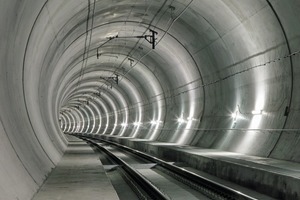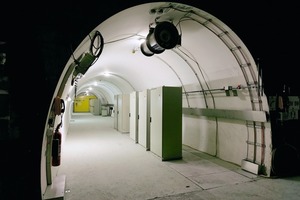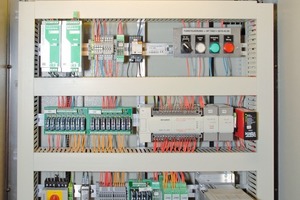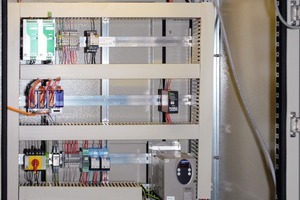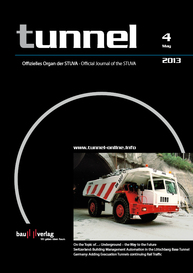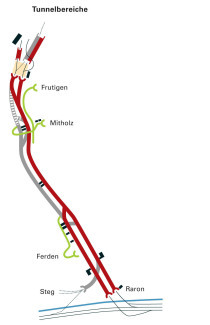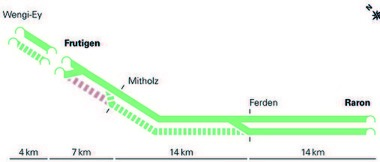Between Aspiration and Reality – Building Management Automation in the Lötschberg Base Tunnel
There is frequently an enormous gap between the original plans and reality particularly in conjunction with major projects – the Berlin Brandenburg Airport or the Elbe Philharmonic Hall serve as examples. Cost and time pressure lead to a botched situation and patchwork – with the operator called on to cough up. The example of the Lötschberg Base Tunnel in Switzerland reveals the problems operators have to contend with and how these can be partly resolved thanks to modern building management solutions.
Everyone involved takes the ideal case for the automation of infrastructure schemes. In the ideal case, the operator knows what he requires for subsequent operation, being able to communicate these requirements 100 % to his planner. The planner for his part understands what the client is saying and is able to work out complete specifications. These specifications are then implemented precisely by the service providers and general contractors. However reality is very different: the client is not completely aware of his operational requirements during the planning phase. What he is aware of is only partially passed on. The planner fails to understand everything that is passed on and is unable to specify and document all the details within acceptable limits. These requirements are then implemented with minimal cost by the general contractor, equipment manufacturer or integrator once they have been awarded the contract.
Retrofitting the MSR Automation Technology
The 32 km Lötschberg Base Tunnel is the third longest rail tunnel in the world (Fig. 1), and was produced by a JV on behalf of the Swiss state. The budget (4.3 billion CHF) and the timetable were adhered to. The operator BLS AG took over a functioning tunnel in 2007. It costs 22.5 million CHF per year to operate.
Individual tenders were invited for the various technical infrastructure sectors. “Saia PCD” control devices were applied for ventilation/air-conditioning, radio and fire protection (30,000 E/A data points) as original equipment. Five further types of control (more than 1,000 automatic units) from various manufacturers were used for the other technical sectors (water supply, lighting, low-frequency monitoring, doors and gates) (Fig. 2). Mostly these were favourably priced compact units, which in some cases could not be programmed. They were attached to control systems via complex structures, gateways, converters and multiplexers. However, direct communication between the sectors was not possible.
The tunnel’s automation or MSR technology (MSR for measurement, control and regulation) turned out to be inadequate for the purpose after being tried out for 2 years. The maintenance costs for the infrastructure technology were practically twice as high as the actual operating costs. On average, there were 50 “hot” alarm signals per day, which in each case required intervention by a 2-man service team. It was impossible to find the necessary qualified personnel for this purpose. In 2010, the operator embarked on a modernisation programme for the control technology with a 18 million CHF budget. This has been successfully concluded in the interim (Figs. 3 + 4). The proprietary automation technology was replaced by “Saia PCD” control systems for all sectors (100,000 E/A data points). In addition to all regulation and control functions, it is now possible to integrate the service and management functions for the individual sectors directly. In the meantime, the administrative council of Switzerland’s second biggest rail company has accordingly prescribed “lean automation” technology for all infrastructure projects.
How could the expensive modernisation programme been avoided with “lean automation”? It would have been sufficient to provide a binding standard for the capabilities of the MSR technology being used for all sectors during the planning phase. That signifies that MSR automation units for the 1,500 control cabinets would have had to be freely programmable and set up on a modular basis. Communication to and between the MSR automation units would have to have been without proprietary, manufacturer-specific certificates. The units would have possessed SPS-conform hardware quality according to Standard IEC 61131-2. After the 18 million CHF was spent for retrofitting the Lötschberg Base Tunnel, this standard has now been attained. If this minimal standard had been insisted on during planning and execution, this would have resulted in additional costs of 0.5 million CHF at the most quite apart from saving a great deal of effort and stress.
Lean Automation
Lean means relying on the fact that many important requirements are initially not clearly defined and that nothing is surer than constant change. These represent the core elements of a lean way of thinking. The adaptability of automation is also in keeping with maximal integral creation of value during planning, construction and operation. Lean automation’s primary target is to attain the maximal exploitation of value and quality from the given resources. This can only be achieved if the user/operator has a system available that is entirely commensurate with his requirements. No prefabricated standard solution in building automation can achieve this. Adjustments during the execution and operating phase are always essential. This adaptation process also entails that effects resulting from the usual planning and tendering separately for each sector are corrected during the operating phase. It would be “non-lean” to discard valid practice and proclaim a better ideal world of integral overall planning. It is lean to accept realities and to adapt oneself to them.
The first step towards a lean automation process is to regard an optimisation phase as a normal component of a process. In able to implement the recognitions from the optimisation phase in a straightforward and cost-favourable manner, Jürgen Lauber [1, 2] is convinced that it is necessary to install technology, which can be changed, expanded and combined with other manufacturers/sectors. This basic capability should be defined as standard for all projects of an owner/operator and put into practice. Substantial problems would then not be encountered even given gaps or false assumptions during planning, tendering or execution. Further details on this topic are to be found in [1, 2].
Summary
The example of the Lötschberg Base Tunnel shows that lean automation is effective and necessary even outside of classic building technology. Non-lean constellations and non-lean technology exert serious negative effects for all projects in which there is a division of work and role involving the owners, planners, constructors, operators, general contractors etc. – in other words also for tunnels.

